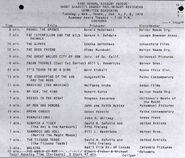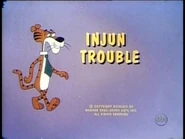TheBigGnome (talk | contribs) No edit summary |
TheBigGnome (talk | contribs) (Unapproved category) |
||
| (6 intermediate revisions by 4 users not shown) | |||
| Line 17: | Line 17: | ||
|Sound effects = Don Douglas<br>[[Hal Geer]] |
|Sound effects = Don Douglas<br>[[Hal Geer]] |
||
|Musician = [[William Lava]] |
|Musician = [[William Lava]] |
||
| − | |Gallery = <gallery type="slideshow"> |
+ | |Gallery = <gallery type="slideshow" widths ="244"> |
Injun_Trouble_1969_TC_Character.jpg |
Injun_Trouble_1969_TC_Character.jpg |
||
Injun_Trouble_1969_TC_Better_Quality.jpg |
Injun_Trouble_1969_TC_Better_Quality.jpg |
||
| Line 64: | Line 64: | ||
== Controversy == |
== Controversy == |
||
| − | + | Barring its appearance on the syndicated version of ''[[The Merrie Melodies Show]], ''"Injun Trouble" has never seen widespread television or home media release, largely in part to the American Indian stereotypes. While bootleg versions are available (most commonly with a time code on the print)<ref>[http://en.wikipedia.org/wiki/Injun_Trouble_(1969_film)#cite_note-0 Wikipedia]</ref>, this short is considered one of the rarest cartoons in Warner Bros. filmography and is only likely to be sought out by the most purist of fans since the short was created during the twilight years of Warner Bros. animation studios (post-1964), which is considered the worst era (compare with the "[[Censored Eleven]]," which were produced during the studio's heyday, and is sought after by casual and hardcore fans alike, mostly for historical reasons and general curiosity as to just how racially "offensive" the Censored Eleven is purported to be). |
|
== Notes == |
== Notes == |
||
| − | * |
+ | * This cartoon is the final entry in the original ''[[Looney Tunes]]'' and ''[[Merrie Melodies]]'' series. |
| − | *This is the |
+ | *This is the second of only two [[Cool Cat]] shorts to be directed by [[Robert McKimson]] (the first one being [[Bugged by a Bee]]). |
| − | *This |
+ | *This short and [[Bugged by a Bee]] are both the last Merrie Melodie and Looney Tune cartoon respectively to be released during the Golden Age of Animation. |
| − | **The previous short that was released before this cartoon, [[Bugged by a Bee]], was the final Looney Tunes short to be released during the Golden Age of American Animation. |
||
* The cartoon shares its name with an [[Injun Trouble (1938 film)|earlier short]] directed by [[Bob Clampett]], which was filmed in black-and-white, but is not related to it. |
* The cartoon shares its name with an [[Injun Trouble (1938 film)|earlier short]] directed by [[Bob Clampett]], which was filmed in black-and-white, but is not related to it. |
||
| − | * [[Warner Bros.]] cartoons would resume production in [[1979]], though |
+ | * [[Warner Bros.]] cartoons would resume production in [[1979]], though the cartoons created in 1979 would be made for television rather than for the theaters. Warner Bros. wouldn't release another theatrical cartoon until around 1987, with ''Night of the Living Duck'' and ''The Duxorcist''. |
== Gallery == |
== Gallery == |
||
Revision as of 11:58, 16 December 2019
Deprecated
We have moved to portable infoboxes using the new Template:Shorts
Please do not use this template anymore. It is left here for reference purposes.
| Injun Trouble | |||||||||||||||||||||||||||||||||||||||||||||
| |||||||||||||||||||||||||||||||||||||||||||||
|
Injun Trouble is a 1969 Merrie Melodies short directed by Robert McKimson.
Title
The title is a play on the phrase "engine trouble," substituting "Injun" which is slang for "Indian" or Native American.
Plot
Cool Cat is driving to the town of Hotfoot one day, when his route happens to take him through a Indian reservation. Two scouts spot him and one of them gives chase, only to fall into a chasm when the weight of him and his horse causes the makeshift bridge to collapse (even though it had carried Cool Cat and his car without trouble). Cool Cat rescues them and continues his journey. Along the way, he encounters a man who tries to give his heavily obese daughter away, a more attractive woman that invites him for an "Indian Wrestle" (which turns out to be a fight with a man who is far larger than Cool Cat), a literal bareback rider and a Native American who uses a stenograph-like device to create smoke signals which read "COOL CAT GO HOME!"
Finally arriving in Hotfoot, Cool Cat spots two horses playing human shoes. After that, Cool Cat spots a "Topless Saloon" and heads in, but finds out that the only topless person in there is the bartender, a rather burly man. An outlaw named Gower Gulch then arrives and seemingly challenges Cool Cat to a duel, but then settles for a game of poker. Cool Cat gets a good hand with four Aces, only for Gulch to get a Royal Flush. Announcing that he is "cutting out," Cool Cat produces a pair of scissors and cuts a hole out of the background, which he then disappears into. He then reappears for a moment and ends the cartoon (and series) with the words "So cool it now, ya hear?"
Controversy
Barring its appearance on the syndicated version of The Merrie Melodies Show, "Injun Trouble" has never seen widespread television or home media release, largely in part to the American Indian stereotypes. While bootleg versions are available (most commonly with a time code on the print)[1], this short is considered one of the rarest cartoons in Warner Bros. filmography and is only likely to be sought out by the most purist of fans since the short was created during the twilight years of Warner Bros. animation studios (post-1964), which is considered the worst era (compare with the "Censored Eleven," which were produced during the studio's heyday, and is sought after by casual and hardcore fans alike, mostly for historical reasons and general curiosity as to just how racially "offensive" the Censored Eleven is purported to be).
Notes
- This cartoon is the final entry in the original Looney Tunes and Merrie Melodies series.
- This is the second of only two Cool Cat shorts to be directed by Robert McKimson (the first one being Bugged by a Bee).
- This short and Bugged by a Bee are both the last Merrie Melodie and Looney Tune cartoon respectively to be released during the Golden Age of Animation.
- The cartoon shares its name with an earlier short directed by Bob Clampett, which was filmed in black-and-white, but is not related to it.
- Warner Bros. cartoons would resume production in 1979, though the cartoons created in 1979 would be made for television rather than for the theaters. Warner Bros. wouldn't release another theatrical cartoon until around 1987, with Night of the Living Duck and The Duxorcist.
Gallery
TV Title Cards
References
External Links





































